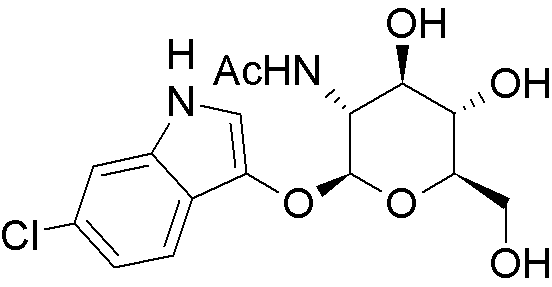6-Chloro-3-indoxyl-N-acetyl-b-D-glucosaminide is widely utilized in research focused on:
- Biochemical Assays: This compound serves as a substrate in various enzymatic assays, allowing researchers to study enzyme activity and kinetics effectively.
- Drug Development: It plays a role in the synthesis of potential pharmaceutical agents, particularly in targeting specific biological pathways, which can lead to the development of new therapies.
- Diagnostics: The compound is used in diagnostic tests, particularly in identifying certain bacterial infections by acting as a chromogenic substrate.
- Cell Biology: It is applied in cell culture studies to investigate cellular processes, including glycosylation patterns and their effects on cell function.
- Research on Glycobiology: This chemical aids in the exploration of carbohydrate-protein interactions, providing insights into cellular communication and signaling mechanisms.
General Information
Properties
Safety and Regulations
Applications
6-Chloro-3-indoxyl-N-acetyl-b-D-glucosaminide is widely utilized in research focused on:
- Biochemical Assays: This compound serves as a substrate in various enzymatic assays, allowing researchers to study enzyme activity and kinetics effectively.
- Drug Development: It plays a role in the synthesis of potential pharmaceutical agents, particularly in targeting specific biological pathways, which can lead to the development of new therapies.
- Diagnostics: The compound is used in diagnostic tests, particularly in identifying certain bacterial infections by acting as a chromogenic substrate.
- Cell Biology: It is applied in cell culture studies to investigate cellular processes, including glycosylation patterns and their effects on cell function.
- Research on Glycobiology: This chemical aids in the exploration of carbohydrate-protein interactions, providing insights into cellular communication and signaling mechanisms.
Documents
Safety Data Sheets (SDS)
The SDS provides comprehensive safety information on handling, storage, and disposal of the product.
Product Specification (PS)
The PS provides a comprehensive breakdown of the product’s properties, including chemical composition, physical state, purity, and storage requirements. It also details acceptable quality ranges and the product's intended applications.
Certificates of Analysis (COA)
Search for Certificates of Analysis (COA) by entering the products Lot Number. Lot and Batch Numbers can be found on a product’s label following the words ‘Lot’ or ‘Batch’.
*Catalog Number
*Lot Number
Certificates Of Origin (COO)
This COO confirms the country where the product was manufactured, and also details the materials and components used in it and whether it is derived from natural, synthetic, or other specific sources. This certificate may be required for customs, trade, and regulatory compliance.
*Catalog Number
*Lot Number
Safety Data Sheets (SDS)
The SDS provides comprehensive safety information on handling, storage, and disposal of the product.
DownloadProduct Specification (PS)
The PS provides a comprehensive breakdown of the product’s properties, including chemical composition, physical state, purity, and storage requirements. It also details acceptable quality ranges and the product's intended applications.
DownloadCertificates of Analysis (COA)
Search for Certificates of Analysis (COA) by entering the products Lot Number. Lot and Batch Numbers can be found on a product’s label following the words ‘Lot’ or ‘Batch’.
*Catalog Number
*Lot Number
Certificates Of Origin (COO)
This COO confirms the country where the product was manufactured, and also details the materials and components used in it and whether it is derived from natural, synthetic, or other specific sources. This certificate may be required for customs, trade, and regulatory compliance.


